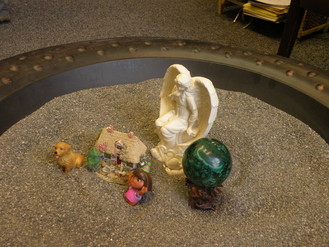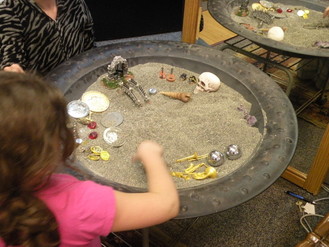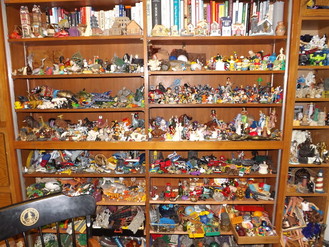
Sand Tray, Art, and Play Therapies
The sand tray, art, and play therapies I use are all designed simply to be ways of expressing unconscious/non-rational understanding and knowledge. As such the quality of the expression in terms of being "artistic" isn't important - the only thing that's important is letting this get expressed, however that looks. If you can draw a stick figure you can do art therapy. In fact, if you can draw a stick figure you can do art therapy as well as an accomplished artist, and often better (because the artist often gets caught up in being artistic instead of just expressive).
Much like the old word-association and Rohrshach ink blot exercises, these therapies provide a neutral canvas which our unconscious can fill as it likes.
I do a wide variety of things in this area, and do not ask clients to do things that cause them high anxiety or bring up feelings of inadequacy or shame. The individual activity chosen is tailored to each person. It can be as simple as bringing in the lyrics of your favorite songs, or selecting the pictures from a magazine that somehow appeal to you.
I usually do play therapies when working with children, but I also have adults try some when that is appropriate. I strongly believe that therapy needs moments of humor, spontaneity, and fun. It is difficult to try new things or make changes when you feel under attack, or that everything rides on what you choose and what you do. Play is how chlidren and animals work through real-world solutions in a safe way. Adults can forget how effective it can be.
To a highly rational person (such as I have been much of my life) many (or all) of these therapies may seem strange, highly uncomfortable, or daunting. I understand! Most often one of the great benefits of doing them is the discovery that our unconscious thinking is every bit as smart and helpful as our conscious thinking -- that we can trust it and gain from having better access to it.
Lastly, a word about sand tray therapy.
I use sand tray therapy (sometimes called sand play therapy) the most frequently of all the creative therapies.
Sand tray to me is very much like being able to "dream on demand." In it a person simply selects from several hundred objects a few that somehow appeal to him or her, without any conscious effort to make sense or connections about the objects being picked.
Next they simply take these objects and arrange them in a bed of dry or wet sand. The arrangement is entirely done by what they feel like doing, and can be very simple or very elaborate.
And that's it.
What follows is a conscious, analytical exploration of the objects and the associations they bring up for the client -- and almost without fail this yields a surprising amount of meaning. The unconscious non-rational mind speaks in the language of dreams, which is to say that it speaks in terms of symbols, icons, associations and the relational attributes of things, not the rational aspects of the things themselves. Sand tray helps "interpret" that language into conscious rational cognition.
It is one of the most powerful tools I've found in 20+ years of providing therapy.
I use sand tray with both adults and children. Despite the initial impression most clients have that I have a wall of children's toys in my office, I primarily use sand tray with adolescents and adults, because with htem it is more effective. Children are often too used to playing in the sand to get past automatically doing "what they are supposed to do" with it -- following the childhood rules rather than being as creative. Adults have forgotten those rules!
Below are a random set of sand tray exercises done by clients. Note: NONE ARE "BETTER" THAN ANY OTHER. Their value only lies in if they were useful or not to the client.
Where to Find Me
Uncommon Therapy
565 University Avenue
Fairbanks, AK 99701
APPOINTMENTS:
(907) 459-8200
Office: (907) 374-8777
Text: (907) 388-8963
(best method)
Email: uncommon.alaska@gmail.com
Or use our contact form.
Office Hours
Monday - Friday 9 AM - 6 PM
Saturday and other hours by arrangement
ONLINE SESSIONS AVAILABLE
Patient Forms
click on the button bekow for on-line forms











